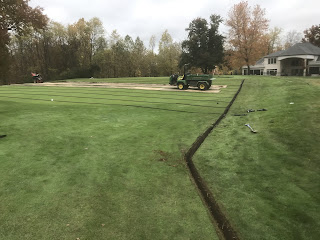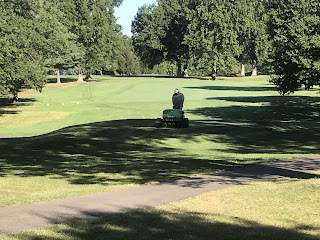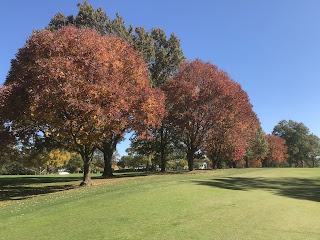The grounds department has been extremely busy tackling many fall projects.
Golf Preservations has installed drain tile into two poorly draining soil based greens. There are many benefits to having a better drainage system installed, some of them are as follows:
- increase turf quality
- increase green speeds
- create firmer conditions
- decrease compaction
- increase root depths
- allow greens to be opened up quicker after a rain storm
- decrease disease presence
It takes about a day to finish a green. They first survey the green, then map out the location of the drainage, cut the sod, dig the trench, remove the spoils, install 2" perforated pipe, back fill with a 6-2-2 (sand, peat moss, topsoil) mix, and finally place the sod back on the trench and install valve boxes for flush out areas. The tile is placed around 15"-16" below the surface and drains out to the lowest point on the green. Holes #6 and #2 will be closed for a short time to allow the sod to root in.
 |
| Golf Preservations trailer |
 |
| #6 green drainage install |
 |
| digging trenches on #6 green |
 |
| main drainage trench |
 |
| Using plywood to minimize disturbance to the green |
 |
| back filling ditches and installing the old bentgrass back on top |
 |
| Drainage completed #6 green |
 |
| Drainage install #2 green |
 |
| Main trench for #2 green |
 |
| Completed drainage project #2 green |
 |
| We were able to replenish the fairway/tee nursery with leftover bentgrass sod |
 |
| #2 green after a rain storm, before the installation of new drainage |
 |
| #6 green after a rain storm, before the installation of new drainage |
Another project taking place, with the help of Russ Macke, is the expansion of three forward/alternate tees. These small tees on #7, #9, and #17 will be enlarged by 2 to 3 times their current size and leveled out. We are using the excavated dirt from #6 and #2 greens drainage projects to help with this job. Hopefully, this will encourage golfers to use these tees more often, decreasing some usage of the further back tees and alleviating their leveling concerns. Drainage has been an issue at the front of #13 green and we have installed new drain tile and a catch basin to try and resolve the problem.
 |
| Excavating the sod on #9 forward tee |
 |
| Excavating the sod on #17 alternate tee |
 |
| Using the spoils from #6 green drainage project for the expansion of #9 forward tee |
 |
| Leveling of the expanded #7 forward tee |
 |
| Newly sodded #9 forward tee |
 |
| Drainage added to the beginning of #13 green |
 |
| New drainage installed #13 green |
Our other fall maintenance projects are moving along nicely. Aeration of tees, fairways, and rough have been completed, as well as, early fall fertilization.The turf has responded well to these practices and is showing off its bright green colors as we speak.
 |
| Aeration of #6 fairway |
 |
| Aeration of #1 fairway |
 |
| Aeration of # 13 tee |
 |
| #2 fairway three weeks after aeration and early fall fertilization |
An athletic field mix of bluegrass was slit seeded into a Bermuda grass area on #11 fairway last month. We are starting to see results as some of the bluegrass has germinated. Right now, it is patchy because the Bermuda grass was extremely thick and healthy when seeding took place. The warm early fall temperatures kept the Bermuda actively growing longer than usual which hindered germination of some of the bluegrass. However, bluegrass is an aggressive creeping grass and it will be interesting to see how it fills in during the late fall season. We will continue to monitor this plot throughout the shoulder season to consider if
Bluemuda (click here for more information) is a potential solution to our Bermuda grass situation.
 |
| Bluegrass germination on #11 test plot. Notice the dark green bluegrass patches mixed in with the brown, dormant Bermuda grass. |
Finally, after completion of these jobs most of our attention will be focused on leaf removal. The WHCC trees are starting to put on their fall show. The ash, maples honey locusts, and hickory trees are in full color. This contrasts well with the bright green turf and allows for some great photo opportunities.
 |
| White ash trees fall color |
 |
| Green ash trees fall color |
 |
| White and green ash by #18 green |
 |
| Sugar maple fall color right of #7 |
We apologize for the inconvenience that these projects have caused; however the benefits will be noticed and enjoyed for years to come.
Brad Piecuch
Assistant Superintendent/Horticulturist





























No comments:
Post a Comment
Note: Only a member of this blog may post a comment.